HOME >> SOURCE
With exports in dismal shape, China relies on consumption
Source:Global Times Published: 2020/3/8 19:25:06

Two customers walk out of a shopping mall in Nanjing, East China's Jiangsu Province on February 19. Photo: cnsphotos
The latest release of China's January-February trade data, which saw exports and imports fall sharply because of the coronavirus outbreak, may forebode a gloomy outlook for the country's external market, indicating that one of its key engines of growth may not function properly this year.
Specifically, except with ASEAN countries, China's trade numbers with its major trading partners like the European Union, the US, and Japan have all plummeted in the first two months of 2020, with exports to the US alone dropping 26.5 percent year-on-year to 300.1 billion yuan ($43.3 billion).
As China's major export destinations, the US, Europe and Japan have all witnessed a significant rise in their coronavirus caseloads. If the outbreak exacerbates, disruptions to the global industrial chain will probably weigh down global demand, putting significant pressure on China's exports in the coming months.
Moreover, China ran a trade deficit of 42.59 billion yuan in the January-February period, compared to the surplus of 293.48 billion yuan in the first two months last year. With the guarantees by government policies and some factors like the purchase promises in the US-China phase one trade deal, China's imports are likely to be less affected compared with exports.
That is to say, China needs to get prepared for a marked drop in its trade surplus as net exports, one of the engines of growth, are expected to make a much weaker contribution to economic growth this year.
Whether the Chinese economy can regain its growth momentum and achieve the original economic targets of doubling its 2010 GDP and the per capita income at the end of this year will depend on domestic demand.
It is true that the Chinese government has made a quick response and great efforts to support production resumption in the wake of the coronavirus outbreak. Yet, small businesses, which account for 60 percent of GDP and create 80 percent of the jobs in China, have seen slow progress in business resumption. As of Friday, only 52 percent of small-sized and micro businesses had reopened, according to the Ministry of Industry and Information Technology.
For the enterprises in the services sector, to restore sales and replenish cash flow will be more crucial to their survival than raw materials or cutting operating costs. So how to reboot consumption and restore demand is the real challenge facing China's economic policymakers.
Without an effective recovery in domestic consumption, newly produced goods will pile up, and corporate debt will worsen. If the enterprises which have restarted operations only to find a cooling market demand, that will spell some larger problem for the Chinese economy. In this sense, whether consumption that has been hit hard by the virus epidemic could recover in a timely manner, will be a decisive factor for bringing the Chinese economy back into gear.
Though we never doubt a rebound in China's domestic consumption after the epidemic comes to an end, a quick and strong rebound is needed for business resumption across the country. We hope the government takes more proactive measures to restore normal market demand and consumption confidence as soon as possible.
Posted in: GT VOICE